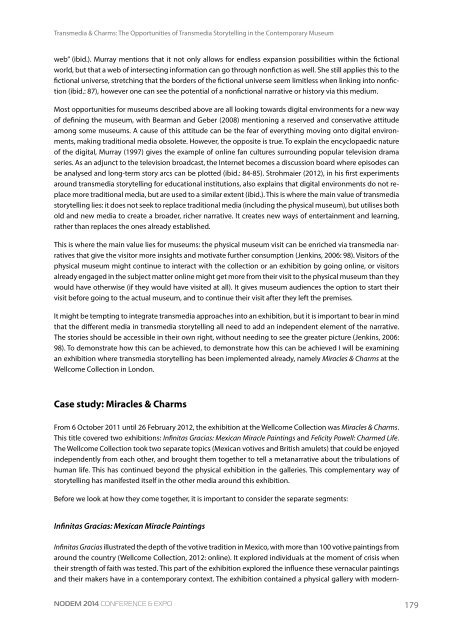NODEM 2014 Proceedings
NODEM 2014 Proceedings
NODEM 2014 Proceedings
You also want an ePaper? Increase the reach of your titles
YUMPU automatically turns print PDFs into web optimized ePapers that Google loves.
Transmedia & Charms: The Opportunities of Transmedia Storytelling in the Contemporary Museum<br />
web” (ibid.). Murray mentions that it not only allows for endless expansion possibilities within the fictional<br />
world, but that a web of intersecting information can go through nonfiction as well. She still applies this to the<br />
fictional universe, stretching that the borders of the fictional universe seem limitless when linking into nonfiction<br />
(ibid.: 87), however one can see the potential of a nonfictional narrative or history via this medium.<br />
Most opportunities for museums described above are all looking towards digital environments for a new way<br />
of defining the museum, with Bearman and Geber (2008) mentioning a reserved and conservative attitude<br />
among some museums. A cause of this attitude can be the fear of everything moving onto digital environments,<br />
making traditional media obsolete. However, the opposite is true. To explain the encyclopaedic nature<br />
of the digital, Murray (1997) gives the example of online fan cultures surrounding popular television drama<br />
series. As an adjunct to the television broadcast, the Internet becomes a discussion board where episodes can<br />
be analysed and long-term story arcs can be plotted (ibid.: 84-85). Strohmaier (2012), in his first experiments<br />
around transmedia storytelling for educational institutions, also explains that digital environments do not replace<br />
more traditional media, but are used to a similar extent (ibid.). This is where the main value of transmedia<br />
storytelling lies: it does not seek to replace traditional media (including the physical museum), but utilises both<br />
old and new media to create a broader, richer narrative. It creates new ways of entertainment and learning,<br />
rather than replaces the ones already established.<br />
This is where the main value lies for museums: the physical museum visit can be enriched via transmedia narratives<br />
that give the visitor more insights and motivate further consumption (Jenkins, 2006: 98). Visitors of the<br />
physical museum might continue to interact with the collection or an exhibition by going online, or visitors<br />
already engaged in the subject matter online might get more from their visit to the physical museum than they<br />
would have otherwise (if they would have visited at all). It gives museum audiences the option to start their<br />
visit before going to the actual museum, and to continue their visit after they left the premises.<br />
It might be tempting to integrate transmedia approaches into an exhibition, but it is important to bear in mind<br />
that the different media in transmedia storytelling all need to add an independent element of the narrative.<br />
The stories should be accessible in their own right, without needing to see the greater picture (Jenkins, 2006:<br />
98). To demonstrate how this can be achieved, to demonstrate how this can be achieved I will be examining<br />
an exhibition where transmedia storytelling has been implemented already, namely Miracles & Charms at the<br />
Wellcome Collection in London.<br />
Case study: Miracles & Charms<br />
From 6 October 2011 until 26 February 2012, the exhibition at the Wellcome Collection was Miracles & Charms.<br />
This title covered two exhibitions: Infinitas Gracias: Mexican Miracle Paintings and Felicity Powell: Charmed Life.<br />
The Wellcome Collection took two separate topics (Mexican votives and British amulets) that could be enjoyed<br />
independently from each other, and brought them together to tell a metanarrative about the tribulations of<br />
human life. This has continued beyond the physical exhibition in the galleries. This complementary way of<br />
storytelling has manifested itself in the other media around this exhibition.<br />
Before we look at how they come together, it is important to consider the separate segments:<br />
Infinitas Gracias: Mexican Miracle Paintings<br />
Infinitas Gracias illustrated the depth of the votive tradition in Mexico, with more than 100 votive paintings from<br />
around the country (Wellcome Collection, 2012: online). It explored individuals at the moment of crisis when<br />
their strength of faith was tested. This part of the exhibition explored the influence these vernacular paintings<br />
and their makers have in a contemporary context. The exhibition contained a physical gallery with modern-<br />
<strong>NODEM</strong> <strong>2014</strong> Conference & Expo<br />
179


